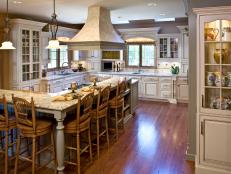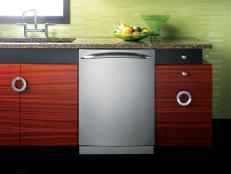How to Choose a Ventilation Hood

Merillat
When shopping for a ventilation hood, quality and strength are important factors to consider. "The home cooking process is the number one source of airborne pollutants in the house," says Brian Wellnitz, marketing manger for Broan-NuTone, a manufacturer of ventilation products. "The purpose of vent hoods is to capture smoke, odors, humidity and heat at the source before they dissipate into the house."
Stylish Kitchen Hood Treatments
See All PhotosConsiderations When Choosing a Ventilation Hood
- What improvements are standard for homes in your area?
- What is your budget?
- What type of vent do you want?
- What features do you want?
Ducted vs. Non-Ducted Hoods. Ideally, the unwanted elements of smoke, odor, humidity and heat would be exhausted outside the house with a ducted vent hood. The next best solution is to filter and recirculate the air back into the kitchen using a non-ducted vent hood. Which one a homeowner selects, says Wellnitz, often comes down to kitchen layout, style of range and budget.
While a non-ducted hood does a pretty good job of eliminating grease and odor when the filters are regularly cleaned and replaced, Wellnitz says they do not eliminate heat and humidity from the home.
Size and Strength. Vent hoods, both ducted and non-ducted, must be adequately sized for the job. "Hoods need to be designed around the size and strength of the range," Wellnitz says. "A properly sized hood must cover the full width of the range and at least 50 percent of the front burners."
A vent hood's strength is quantified by the amount of air it moves, represented in CFMs (cubic feet per minute). The Home Ventilating Institute (HVI), a nonprofit organization that certifies residential ventilation products, recommends a minimum of 40 CFM for every linear foot of range. In the case of gas cooktops, the rule of thumb is 1 CFM for every 100 BTUs (british thermal units, a measurement of energy content) of burner power. Wellnitz advises buyers to look for HVI-rated products.
Types of Vent Hoods
Under-cabinet. The economical choice when it comes to vent hoods is a non-ducted under-cabinet hood, says Wellnitz. Starting as low as $50, these basic units recirculate the air back into the kitchen, trapping a portion of the grease and odors in replaceable filters. The performance of under-cabinet models is boosted significantly when ducted out-of-doors. Ducted models are priced from $175 to $250, not counting installation.
Wall-mounted chimney. These mid-range vent hoods combine form and function in a moderately priced appliance. Unlike under-cabinet models, these units are installed against the wall of the kitchen. They are called "chimney-style" because their shape—pyramidal base with a rising rectangular column—resembles the shape of a home chimney. Homeowners can expect to pay between $500 and $700, not counting installation, says Wellnitz.
Ceiling-mounted chimney. Also called "island hoods," these higher-end models are suspended from the ceiling over the kitchen's cooking island. Dramatic in scale and placement, these popular hoods come in sleek European glass styles, chunky pro-style stainless, and pretty much everything in between. Homeowners can expect to pay between $1,200 and $2,500, not counting installation, Wellnitz says. But when it comes to custom units, "The sky is the limit."
Custom built-in. Designed to blend seamlessly with a home's kitchen cabinetry, built-in ventilation is installed into a section of the wall. Instead of a chimney-style hood, it relies on "power packs" or modules that are mounted and ducted in a non-obtrusive manner. Prices are wholly dependent upon the specific application.
Features
In general, within categories of products, as the price goes up the performance increases, the operation gets quieter, and the controls move from mechanical to electronic," Wellnitz says.
While basic under-cabinet units will have a manual on-off switch—maybe a two-speed fan—higher-end units will feature digital controls with variable-speed fans. Some even boast sensors for heat and particulate (tiny particles of a substance) that automatically turn the blower on and off.
As units go up in price they will also feature better and brighter lighting. Generally the steps move from incandescent to halogen and, in Energy Star approved units, fluorescent. The next wave, says Wellnitz, will be LED.







































